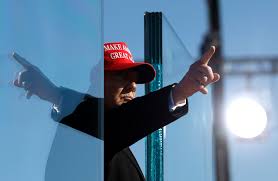In the wake of the success that statewide Republican candidates experienced in 2024, some political analysts are suggesting that Pennsylvania might be headed in the same direction as Florida – a state that was once a battleground but has since become reliably Republican. Over the last decade, Pennsylvania’s Democratic voter registration advantage has shrunk significantly from 1.2 million to just around 340,000. This shift has raised the question: did Donald Trump’s presidency play a central role in these changes, and what does this mean for Pennsylvania’s future political landscape?
Voter Registration Shifts: The Impact of Presidential Terms
When we look at shifts in voter registration over time, it’s most logical to align these changes with the tenure of a sitting president. The largest partisan change in the state’s history this century took place during George W. Bush’s second term, a period marked by widespread dissatisfaction with his performance. This dissatisfaction led to a surge in Democratic voter registration, resulting in a 1.2 million voter advantage for Democrats by the end of Bush’s presidency.
However, under President Biden’s administration, Pennsylvania saw its largest drop in Democratic registration since the early 2000s. Despite Biden’s position as a Democrat, his presidency has seen declining approval ratings, even among those in his own party, which has had an impact on voter trends in the state.
Trump’s first term, on the other hand, saw the biggest rise in Republican registration this century, but the most significant growth was actually seen in third-party registrations. In fact, third-party and unaffiliated voter registrations have grown more rapidly than those for the two major parties in nearly every presidential administration since 2000, except for the second term of Bush.
While there was some noticeable growth for the Republicans during Trump’s tenure, this shift was more of a gradual trend rather than a dramatic change. A historical look at Pennsylvania shows that more significant shifts occurred during earlier presidential eras, such as Franklin Roosevelt’s New Deal, which deeply transformed the state’s political landscape. Roosevelt’s presidency made it possible for the Democratic Party to truly compete in the state, signaling the end of the Republican dominance.
Trump’s Role: A Shift or Just a Bump?
From a historical perspective, Trump’s influence on Pennsylvania’s voter registration is better described as a small “bend” in a longer trend rather than a significant “bounce.” Although voter registration aligned more with the Republican Party following the 2016 election, the overall shift in the state wasn’t as substantial as other periods of political change.
Comparing Trump’s impact to past political eras, the voter registration changes during his first term are closer to the usual rates of change seen throughout history. Unlike previous major shifts in voter registration that were tied to significant economic recessions, Trump’s era lacked obvious economic tailwinds that could have directly driven a larger change in political alignment.
In fact, many voters reported being financially worse off in 2024 compared to the previous year, yet official economic indicators did not show a recession. Typically, sharp shifts in voter registration are more closely tied to major economic downturns. As such, while Trump’s tenure undoubtedly influenced Pennsylvania’s political landscape, the changes don’t seem to be of the same magnitude as those brought about by earlier presidencies, such as Roosevelt’s or the shifts seen in the 1960s and 1970s.
The Road Ahead: A Competitive Future
While it’s challenging to pinpoint exactly when a major electoral realignment occurs, history teaches us that sometimes the effects of a “critical” election can take years to fully unfold. Some of the most notable shifts in Pennsylvania’s history – such as those driven by Roosevelt and the civil rights movement – were initially small but gradually snowballed into lasting political realignments. The changes seen in the Trump era may not yet have had the same explosive impact as previous eras, but they still hold the potential for future electoral consequences.
The shifts in voter registration over the past decade are largely a reflection of the changing nature of the electorate, particularly the movement away from both major political parties. During Trump’s time in office, more voters registered as third-party or unaffiliated, a trend that has continued even after his presidency.
While the Republican Party has made significant gains in Pennsylvania, especially in the areas of registration, these changes do not yet give them a clear, long-term advantage. The state remains highly competitive, with a shrinking registration edge for Democrats and a growing share of voters who are unaffiliated with any party.
The Democrats had an opportunity in 2008 to cement their political dominance in the state but failed to do so. Now, Republicans have a similar opportunity, not only with Trump’s influence in the White House but also with majorities in both the House and Senate and a sympathetic Supreme Court. Whether they can create a new political coalition that capitalizes on the electorate’s desire for change remains to be seen.
Will Republicans Build a Lasting Coalition?
Republicans now find themselves at a crossroads. While they have the political infrastructure in place to create a lasting advantage, it will ultimately be their policies – not just Trump’s popularity – that will determine whether they can build a sustainable coalition. The next few years could define whether this era of Republican growth in Pennsylvania is a temporary bump or the beginning of a new political alignment.
In conclusion, while Trump’s influence on voter registration in Pennsylvania is undeniable, the changes don’t yet suggest that the state is permanently shifting toward Republican dominance. With both parties in a state of flux and a growing number of voters identifying as unaffiliated, Pennsylvania’s political future remains highly competitive. The coming years will reveal whether the Republican Party can harness these changes to create a lasting political coalition or if the state will return to its traditionally unpredictable, swing state status.
Disclaimer – Our team has carefully fact-checked this article to make sure it’s accurate and free from any misinformation. We’re dedicated to keeping our content honest and reliable for our readers.

